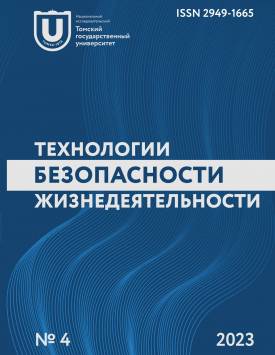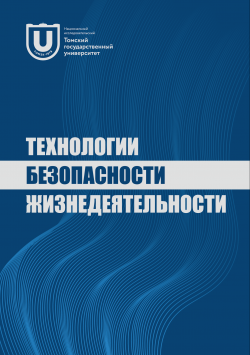Model range of neutralizing aerosol sprayers using HEMs
Currently, the danger of environmental and terrorist threats associated with aerosol emissions of hazardous substances, as well as the spread of biological aerosols carrying bacteria and viruses, is growing. Therefore, it is necessary to develop new methods and devices to quickly neutralize such emissions. Spraying a neutralizing aerosol using HEM energy has a number of advantages associated with a high rate of aerosol generation and a high dispersion of neutralizing particles. The high dispersion of the particles provides them with a large specific surface, which increases the efficiency of their interaction with harmful substances in the air. The paper proposes a number of atomizers based on HEM. Some of them allow you to spray powders for adsorption or catalytic neutralization of harmful substances. Others create a cloud of liquid droplet neutralizing aerosols (such as disinfectants to kill viruses and bacteria). The third approach is the development of special nanothermic mixtures containing a disinfectant. When such thermite burns in the air, a cloud of disinfectant vapors is formed. The results of experiments on the spraying of nanostructured titanium oxide, a disinfectant liquid, are presented. In the experiment, the concentration and particle size of the sprayed aerosol were determined in real time. It has been experimentally and theoretically shown that the sprayed particles have a mass-average diameter of less than 1 pm and remain in the air for at least 10 minutes. A series of experiments was carried out to create an iodine vapor cloud using iodine-containing nanothermites. It has been shown that the use of iodine-containing nanothermites can significantly reduce the microbicidal activity of lactobacilli.Further work will be related to improving the efficiency of the proposed devices. For this, mathematical models will be developed that describe the interaction of titanium oxide particles with harmful substances, and describe the death of microorganisms under the action of disinfectant vapors. The most effective iodine-containing nanothermic compositions for the disinfection of indoor space will be developed. The authors declare no conflicts of interests.
Keywords
aerosol,
sprayer,
neutralizationAuthors
| Gaenko Olga I. | Institute for Problems of Chemical and Energetic Technologies of the Siberian Branch of the Russian Academy of Sciences | yuu-95@mail.ru |
| Muravlev Eugene V. | Institute for Problems of Chemical and Energetic Technologies of the Siberian Branch of the Russian Academy of Sciences | evvimv@gmail.com |
| Kudryashova Olga B. | Institute for Problems of Chemical and Energetic Technologies of the Siberian Branch of the Russian Academy of Sciences; Tomsk State University | olgakudr@inbox.ru |
| Klimenko Victor A. | Institute for Problems of Chemical and Energetic Technologies of the Siberian Branch of the Russian Academy of Sciences | klimenko@siberia.design.ru |
Всего: 4
References
Романов В.И., Романова Р.Л. Выбросы вредных веществ и их опасность для живых организмов. М. : Физматкнига, 2009. 376 с.
Kwon H.S., Ryu M.H., Carlsten C. Ultrafine particles: unique physicochemical properties relevant to health and disease // Experimental & molecular medicine. 2020. Vol. 52 (3). P. 318-328. doi: 10.1038/s12276-020-0405-1.
Jarvis M. C. Aerosol transmission of SARS-CoV-2: physical principles and implications // Frontiers in public health. 2020. Vol. 8. Art. no. 590041. P. 1-8. doi: 10.3389/fpubh.2020.590041.
Kudryashova O.B., Muravlev E.V., Antonnikova A.A., Titov S.S. Propagation of viral bioaerosols indoors // PloS one. 2021. Vol. 16 (1). Art. no. e0244983. P. 1-13. doi: 10.1371/journal.pone.0244983.
Пирумов А.И. Обеспыливание воздуха. М. : Рипол Классик, 1974. 207 с.
Sublett J.L., Seltzer J., Burkhead R., Williams P.B., Wedner H.J., Phipatanakul W. Air filters and air cleaners: rostrum by the American academy of allergy, asthma & immunology indoor allergen committee // Journal of Allergy and Clinical Immunology. 2010. Vol. 125 (1). P. 32-38. doi: 10.1016/j.jaci.2009.08.036.
Fox R.W. Air cleaners: a review // Journal of Allergy and Clinical Immunology. 1994. Vol. 94 (2). P. 413-416.
Василяк Л.М. Физические методы дезинфекции (обзор) // Успехи прикладной физики. 2018. Т. 6, № 1. С. 5.
Luo H., Zhong L. Ultraviolet germicidal irradiation (UVGI) for in-duct airborne bioaerosol disinfection: Review and analysis of design factors // Building and environment. 2021. Vol. 197. Art. no. 107852. P. 1-14. doi: 10.1016/j.buildenv.2021.107852.
Hay S.O., Obee T., Luo Z., Jiang T., Meng Y., He J., Suib S. The viability of photocatalysis for air purification // Molecules. 2015. Vol. 20 (1). P. 1319-1356. doi: 10.3390/molecules20011319.
Бакина О.В., Глазкова Е.А., Сваровская Н.В., Волков А.М., Ворожцов А.Б., Лернер М.И. Электровзрывной синтез наночастиц ZnO-Ag с высокой антибактериальной активностью // Технологии безопасности жизнедеятельности. 2023. № 1. С. 82-90. doi: 10.17223/7783494/1/11.
Kumar S., Pandit V., Bhattacharyya K., Krishnan V. Sunlight driven photocatalytic reduction of 4-nitrophenol on Pt decorated ZnO-RGO nanoheterostructures // Materials Chemistry and Physics. 2018. Vol. 214. P. 364-376. doi: 10.1016/j.matchemphys.2018.04.113.
Qiao C., Ji K., Zhang Z. Research progress of indoor air purification technology //IOP Conference Series: Earth and Environmental Science. IOP Publishing, 2020. Vol. 474 (5). Art. no. 052024. P. 1-5. doi: 10.1088/1755-1315/474/5/052024.
Ram E.S.M. Nanotechnology for Environmental Decontamination. New York: McGraw-Hill. 2011. 448 с.
Stoimenov P.K., Zaikovski V., Klabunde K.J. Novel halogen and interhalogen adducts of nanoscale magnesium oxide // Journal of the American Chemical Society. 2003. Vol. 125 (42). P. 12907-12913. doi: 10.1021/ja030195l.
Matai I., Garg D., Agrawal S., Sachdev A. Nanoengineering-based approaches for antimicrobial materials and coatings // Emerging Nanotechnologies for Medical Applications. Elsevier. 2023. P. 189-226. doi: 10.1016/B978-0-323-91182-5.00008-5.
Хмелев В.Н., Шалунов А.В., Нестеров В.А., Тертишников П.П., Генне Д.В. Ультразвуковое распыление для санитарной обработки дезинфицирующими растворами // Южно-Сибирский научный вестник. 2020. №. 3. С. 37-45. doi: 10.25699/SSSB.2020.21.3.006.
Измайлов Т.Х. Новые эффективные термовозгонные средства дезинфекции для ветеринарии // Эффективное животноводство. 2017. №. 9. С. 8-8.
Сакович Г.В., Комаров В.Ф., Ворожцов А.В., Матвиенко О.В., Пармон В.Н., Воронцов А.В. Нейтрализация токсических веществ при террористических актах и техногенных катастрофах // Известия высших учебных заведений. Физика. 2005. Т. 48, № S11. С. 109-115.
Kudryashova O.B., Stepkina M. Y., Korovina N. V., Antonnikova A.A., Muravlev E. V., Pavlenko A.A. Atomization of nanopowders for adsorption of toxic substances // Journal of Engineering Physics and Thermophysics. 2015. Vol. 88. P. 833-838. doi: 10.1007/s10891-015-1258-7.
Kudryashova O., Sokolov S., Zhukov I., Vorozhtsov A. Mathematical Model of the Pulse Generation of Decontaminating Aerosols // Materials. 2022. Vol. 15 (22). Art. no. 8215. P. 1-13. doi: 10.3390/ma15228215.
Kudryashova O.B., Vorozhtsov B.I., Ishmatov A.N., Akhmadeev I.R., Muraviev E.V., Pavlenko A.A. Physicomathematical modeling of the explosion-induced generation of submicron liquid-droplet aerosols // Aerosols: Properties, Sources and Management Practices. N.Y. : Nova Science Publishers, 2012. P. 227-247.
Муравлев Е.В., Степкина М.Ю., Титов С.С., Ахмадеев И.Р., Павленко А.А., Кудряшова О.Б. Исследование процессов диспергирования компактированных порошков // Ползуновский вестник. 2016. № 4. С. 64-67.
Kudryashova O.B., Vorozhtsov B.I., Muraviev E.V., Akhmadeev I.R., Pavlenko A.A., Titov, S.S. Physicomathematical modeling of explosive dispersion of liquid and powders // Propellants, Explosives, Pyrotechnics. 2011. Vol. 36 (6). P. 524-530. doi: 10.1002/prep.200900101.
Vorozhtsov B.I., Kudryashova O.B., Ishmatov A.N., Akhmadeev I.R., Sakovich G. V. Explosion generation of microatomized liquid-drop aerosols and their evolution // Journal of Engineering Physics and Thermophysics. 2010. Vol. 83 (6). P. 1149-1169. doi: 10.1007/s10891-010-0439-7.
Kudryashova O.B., Muraviev E.V., Vorozhtsov B.I. Generation of a Fine Aerosol in a Cavitation Regime // Journal of Engineering Physics and Thermophysics. 2020. Vol. 93 (5). P. 1138-1146. doi: 10.1007/s10891-020-02215-3.
Johnson C.E., Higa K.T. Iodine-rich biocidal reactive materials // MRS Online Proceedings Library (OPL). 2013. Vol. 1521. Art. no. mrsf12-1521-oo03-07. doi: 10.1557/opl.2013.46.
Wu T., Wang X., Zavalij P.Y., DeLisio J.B., Wang H., Zachariah M.R. Performance of iodine oxides/iodic acids as oxidizers in thermite systems // Combustion and Flame. 2018. Vol. 191. P. 335-342. doi: 10.1016/j.combustflame.2018.01.017.
Muraviev E. V., Pavlenko A.A., Kudryashova O.B., Titov S.S., Korovina N. V., Antonnikova A.A. Model range of devices for creating aerosols using energy of high-energy materials // The 6th International Symposium on Energetic Materials and their Applications, 6-10 November, 2017, Tohoku University, Sendai, Japan. Sendai : Tohoku University, 2017. P. 73.
Gottardi W. Iodine as disinfectant // Iodine chemistry and applications. 2014. P. 375-410. doi: 10.1002/9781118909911.ch20.
Гордеев В.В., Казутин М.В., Козырев Н.В., Кашкаров А.О., Рубцов И.А., Тен К.А., Рафейчик С.И. Исследование механизма горения нанотермитных систем // Ползуновский вестник. 2018. №. 2. С. 96-101.
Kudryashova O., Sokolov S., Vorozhtsov A. Mathematical Model of Propagation of an Aerosol Created by an Impulse Method in Space // Materials. 2023. Vol. 16 (16). Art. no. 5701. P. 1-11. doi: 10.3390/ma16165701.
Kudryashova O.B., Korovina N.V., Pavlenko A.A., Arkhipov V.A., Gol’din V.D., Muravlev E.V. Aerosol Cloud Propagation in a Closed Space // Journal of Engineering Physics and Thermophysics. 2015. Vol. 88 (3). P. 568-575. doi: 10.1007/s10891-015-1224-4.

